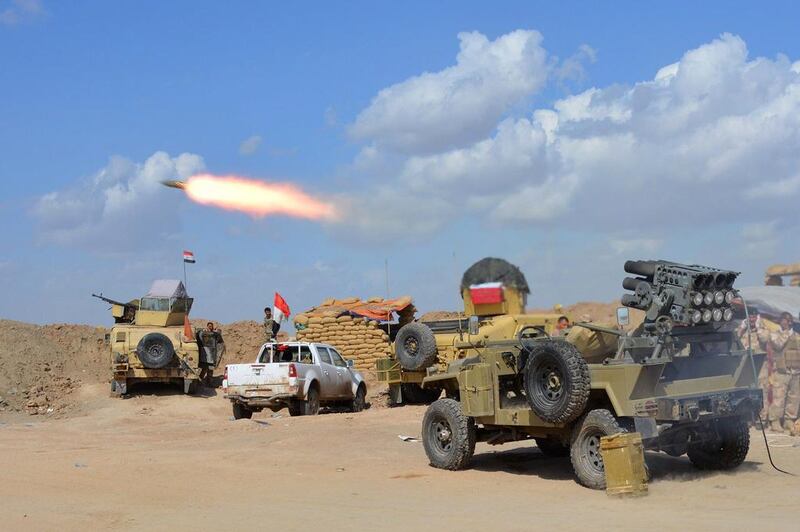KIRKUK // About 30,000 Iraqi troops and militia backed by aircraft pounded ISIL positions in and around Tikrit on Monday in the biggest effort yet to retake the city.
Government forces have been working their way north in recent months, achieving key victories against ISIL.
But troops have so far been resisted in the city of Tikrit, one of ISIL’s main strongholds and the force’s toughest target yet.
After recent successes, commanders hoped that the largest operation since ISIL overran large areas of Iraq and Syria last June would lead to the liberation of Mosul, the extremists’ main base in Iraq.
A senior army officer involved in the assault said security forces were advancing on three main fronts, towards Tikrit, Ad Dawr to the south and Al Alam to the north.
He said forces involved in the battle were from the army, police, counter-terrorism units, fighters from government-controlled Shiite volunteer militias known as Popular Mobilisation units, and local Sunni tribes.
“The attack is being carried out using fighter jets, helicopters and artillery targeting Tikrit to secure the advance and cut supply routes,” the officer said.
A source at local military command said forces advanced north from the city of Samarra towards the town of Ad Dour, which officials also describe as an ISIL bastion, and Tikrit, which is about 40 kilometres north of Samarra.
But they faced heavy opposition from ISIL fighters who have had months to dig in.
They came under attack as they advanced towards Samarra from their base to the east.
Sixteen of the troops – five soldiers and 11 Shiite militia fighters – were killed by gunfire and roadside bombs.
In the same area, a suicide bomber drove a vehicle packed with explosives into a convoy of militia fighters, killing four.
And more than 30 militia fighters were wounded in clashes near Ad Dour.
The operation began early on Monday morning after being announced by prime minister Haider Al Abadi the previous evening.
Military sources said Iraqi warplanes were involved but the Pentagon said that the US and its allies in the war against the extremists were not taking part in air strikes.
Pentagon spokesman Col Steve Warren said the US was alerted to the offensive before it started on Monday but Baghdad did not request air support.
Col Warren said he could not comment on any Iranian military involvement.
But Iraqi and Iranian media said Qassem Suleimani, commander of the Quds Force covert operations unit of Tehran’s elite Revolutionary Guards, was in Salahuddin province to help coordinate operations.
Mr Al Abadi urged the security forces on Sunday to spare civilians during the offensive.
Speaking from Samarra, the other main city in Salahuddin province, he appeared to be addressing fears of reprisals against the Tikrit area’s Sunni population.
“The priority we gave to the armed forces and all the forces taking part alongside them is to preserve the security of citizens,” Mr Al Abadi said.
On social media, he called “for utmost care in protecting civilian lives and property”.
Iraqi forces have tried and failed several times to wrest back Tikrit, a Sunni Arab city on the Tigris River, about 160km north of Baghdad.
The military commander for Salahuddin province, Abdel Wahab Saadi, said Tikrit had symbolic and strategic importance.
“The aim of course is to liberate Salahuddin to allow for the return of displaced families but it is also going to be a stepping stone on the way to liberating Mosul,” Mr Saadi said.
Tikrit is the hometown of the executed Iraqi dictator Saddam Hussein. The remnants of his Baath party have collaborated with ISIL in trying to topple the Shiite-dominated government.
ISIL declared a caliphate last June straddling Iraq and Syria, where the US-led coalition has also been conducting air strikes but not coordinating with any significant ground force.
In Syria, regime forces and Kurdish militia fought separate battles with ISIL on Monday in an area near the Iraqi and Turkish borders, a monitoring group said.
Forces loyal to Syrian president Bashar Al Assad and fighters from the Kurdish People’s Protection Units (YPG) launched uncoordinated offensives against ISIL in the north-eastern province of Hassakeh, the UK-based Syrian Observatory for Human Rights said.
Observatory director Rami Abdel Rahman said that after three days of clashes, regime forces bolstered by tribesmen had secured control of more than 23 villages in the centre of the province from ISIL.
Syria’s official news agency Sana put the number at 31.
State television said the army offensive would continue until it controlled the main road linking the provincial capital Hassakeh and the city of Qamishli.
Meanwhile, Mr Rahman said YPG fighters were battling ISIL alongside Arab tribes outside the village of Tal Tamr in Hassakeh’s south-west.
* Agence France-Presse, Reuters and Associated Press





